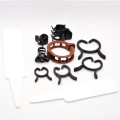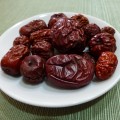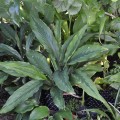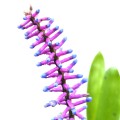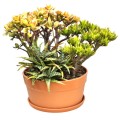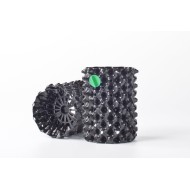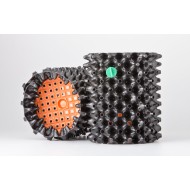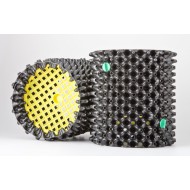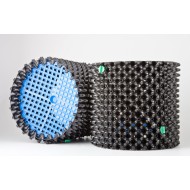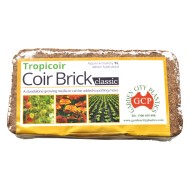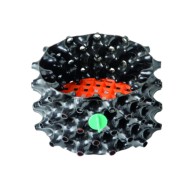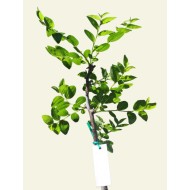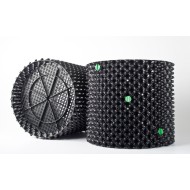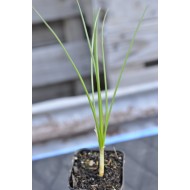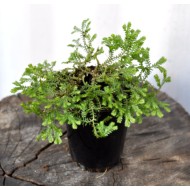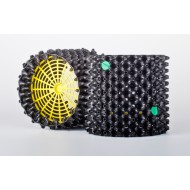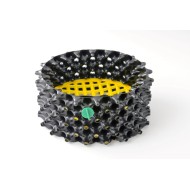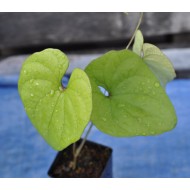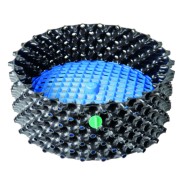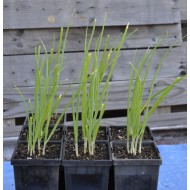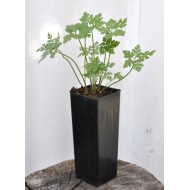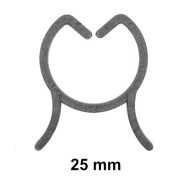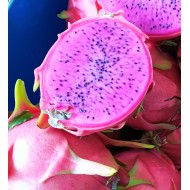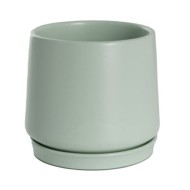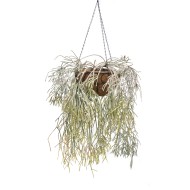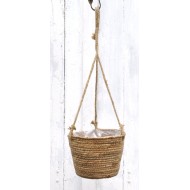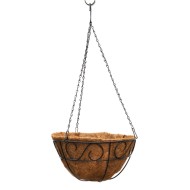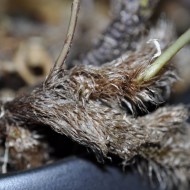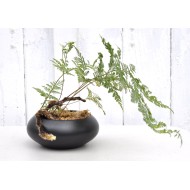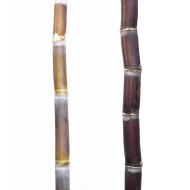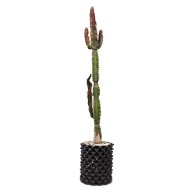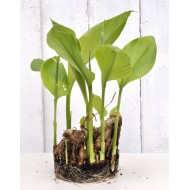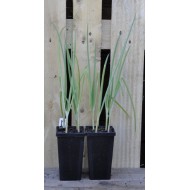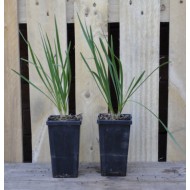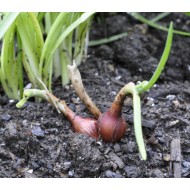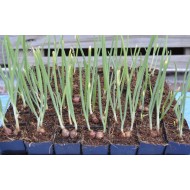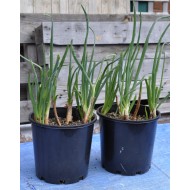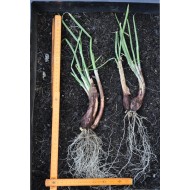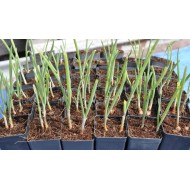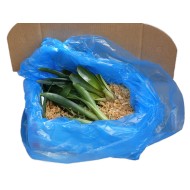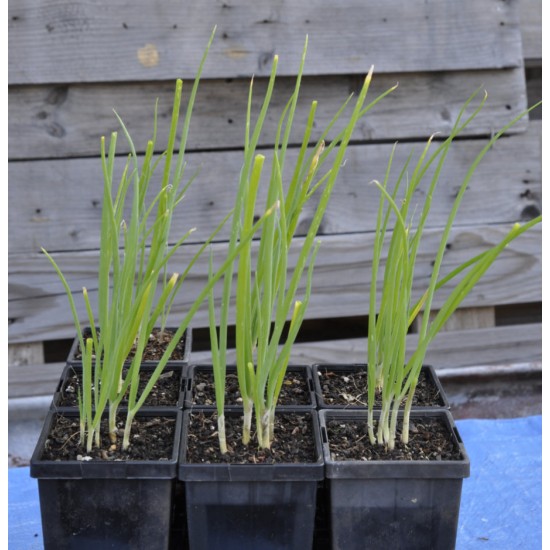
- Stock: Pre-Order
- Model: walking-onion-90mm-bottomless-pot
Family: Amaryllidaceae (includes Amaryllis, Agapanthus, Clivia and Scadoxus)
Genus: Allium (includes onions, leeks, garlics, chives)
Botanical/Binomial Name: Allium × proliferum
Meaning of Name:
Allium, from Latin allium (‘garlic’); and
proliferum, from Latin proliferum (‘prolific’)
Common Names: Walking Onion, Egyptian Walking Onion, Tree Onion, Top-setting Onion
Botanical Characteristics: Herbaceous | Bulbous | Perennial | Evergreen | Frost hardy
Propagation: Bulblets | Division of bulbs
If this is out of stock I may have other walking onion listings here in stock.
I often have different sizes and ages seasonally throughout the year.
Item Description:
Each pot contains a clump of five rooted and shooting bulbils/bulblets (not the larger bulbs). The leaves are between 150 mm-200 mm high.
Please note that leaves may be folded or trimmed if posted so as to keep size and postage down.
Dimensions of the bottomless pot are 90 mm square × 150 mm deep. The square shape and bottomless design produces beautifully straight and deep roots with no spiralling whatsoever, which gives these young plants every advantage once planted out. (I sell these brand-new if interested.)
Plant Description:
A versatile and prolific onion which keeps on giving! Eat the bulbs as onions, and the leaves as spring onion shoots — though please note the bulbs do not grow especially large (shallot-size at best), being a cross between the regular big-bulbed culinary onion Allium cepa and the non-bulb-forming spring/bunching/Welsh onion Allium fistulosum.
Stronger tasting than regular onions or shoots — these little bulbs really pack quite a punch. The top-setting bulblets can also be eaten if you have the patience to prepare them!
When starting out, best to just let these bulbs grow while harvesting the leaves. This way you can produce more onions (and plants) more quickly. You can leave the bulbs in a clump, or separate out to plant individually.
Sometimes in the first year, but more typically by the second year, a tall stem will appear from the centre, with a cluster of bulblets developing on the top. You can pick and eat these (or transplant elsewhere to grow a new plant), or allow the weight of these to bend the leaf over — this is the ‘walking’ part as these bulblets will root in the ground to produce new plants a small distance from the parent.
If the stem doesn‘t bend over, the bulblets will sprout in the air, and one may even produce another stem with bulblets on top — the ‘tree’ part. It‘s the funniest onion plant you‘ll ever see!
The bulblet stems will turn brown and die off. Remaining bulblets not eaten will sprout, and can be picked off for planting elsewhere, or left to root where they make contact with the ground. The original bulb can be dug up and eaten as a larger onion, or will continue to produce edible leaves if left alone.
Growing Information:
The individual plants can be separated before planting out, or planted together in a larger pot or directly into the ground. I grow all our Allium species in a dedicated bed as well as in 3 L and 9 L Air-Pot containers closer to the kitchen, as the entire onion family does especially well in these.
Walking onions grow best in full sun (6-8 hours a day), and in well-draining soil of about pH 6.5 and rich in organic matter.
Walking onions are very hardy and established plants will grow even in snow! Small, new, bulblets may hunker down over winter conserving energy before putting out a leaf in spring. Protecting these new bulblets in very cold winter climates with a layer of mulch doesn’t go astray either.
Wherever and however you grow them, I do wholeheartedly recommend at least some be in a pot by the kitchen for quick access — as with their relatives the spring/bunching/Welsh onions, the leaves readily grow 10 mm thick and 500-600 mm high, making a leaf or two go very far in daily use!
The more you cut, the more they grow back, but I do recommend leaving at least one to two full leaves on each plant at all times.
The unusual growing habit of walking onion plants makes them natural clumpers as well as spreaders, and over time they will fill a space of their own accord. Unless you wish to establish new ‘colonies’ elsewhere via the prolific bulblets, just let them be to propagate of their own accord. Older bulbs will die off over time, but the continuous supply of bulblets ensures dozens more plants will spring up in their place with refreshed vigour every year.
Having said that, once clumps become too dense the individual plants will grow smaller and show other signs of stress, and it is best to divide these clumps and plant anew.
Local pick-up is welcome — we’re in Gwynneville, near Wollongong University.
Pick-up is by mutual arrangement please, as we don’t have a shopfront.
Having said that, we are always here and more often than not can easily fit in with whichever day and time suits you best!
Feel free to suggest preferred pick-up time(s) in the comments box during checkout and we’ll reply as soon as we see the notification.
Especial Note Regarding Large Air-Pot® Orders
Depending on the order, we may suggest that large Air-Pot® orders are best sent directly to you from the warehouse.
Especial Note Regarding Jujube Trees
When posting out bare-rooted jujube trees, we routinely trim them to fit the box and keep postage costs to a minimum. These trees are typically knee-high when planted out, though some may be smaller.
This of course doesn’t apply for pick-ups, and in fact we will set aside the tallest trees specifically for this purpose. These trees can often be hip-high, and sometimes taller again.
Please note that this is not a guarantee, as heights of different cultivars can differ from year to year.

